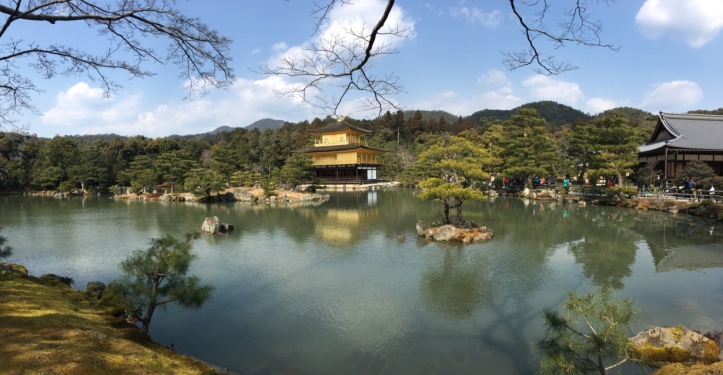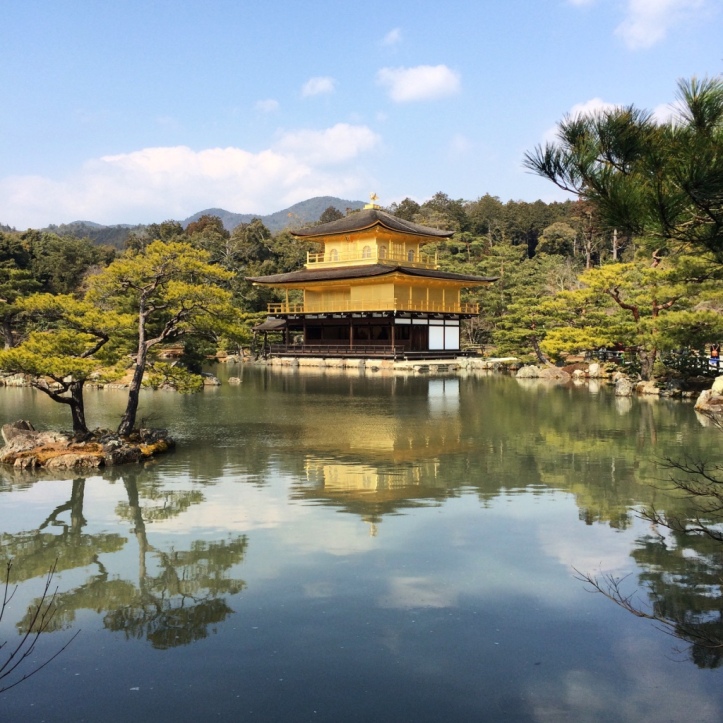Kinkakuji temple is arguably the poster child of tourism in Kyoto (I say arguably because Fushimi Inari’s 10,000 red torii gates are a close contender bringing strength in numbers against Kinkakuji’s bling). It is located on the far west end of Kyoto, but unlike its sister temple Ginkakuji (blog post on it: here) which is on the far east end, there are no major train lines to Kinkakuji.
History
The official name is Rokuon-ji “Deer garden temple”, but similar to Ginkakuji, the gold-leaf covered pavilion gives it the more well-known nickname of Kinkakuji “Golden pavilion”. Also, I didn’t see any deer there.
The pavilion was originally a villa called Kitayama-dai belonging to a powerful statesman, which was then purchased by Shogun (top military commander) Ashikaga Yoshimitsu and transformed into the current complex as his retirement villa. After his death, as per his wishes the temple was converted into a Rinzai Zen Buddhist temple. His grandson emulated a similar design of the pavilion for his own retirement villa across the city, now called Ginkakuji or Silver Pavilion.
Kinkakuji has been through some rough times. During the Onin war (1467-1477), all the buildings except the pavilion were burned down….. twice. Atleast the pavilion was safe….until 1950 when a fanatic and schizophrenic monk burned it down at 2:30am and attempted suicide in the forest behind the temple. But now, Kinkakuji is a World Heritage site, fully restored and well maintained and totally blingy.
Getting there
You can take the Raku bus #101 from Kyoto station and it is a direct route to Kinkakuji, taking around 40 mins. The temple is open all year from 9am to 5pm, and entry costs 400 yen.
Kinkakuji
The Golden pavilion is hard to miss once you enter the temple grounds. It is a 3 storeyed shimmering golden pagoda on the far end of a beautiful pond (Kyoko-chi) which mirrors the temple. All 3 storeys have different architectures and only the top 2 floors are covered completely in gold leaf. The gold was supposed to purify or cleanse your mind of any negative thoughts towards death. But it could also be because the Muromachi period in which it was built was a period of visual excess (the extravagant Kitayama culture) and the sun’s reflection on the gold created an impressive view of the pavilion.

Most tourists were gathered on the opposite side of the lake to take their pictures of Kinkakuji. It took a while to squeeze through everyone to find the perfect angle and lighting to take our pictures with Kinkakuji in the back.
The bottom wooden storey of the pavilion houses statues of Shaka Buddha and Yoshimitsu himself (this one was restored since the original statue was destroyed during the fanatic monk’s fire). If you really want to see these statues, use your camera’s super zoom from across the lake if the front windows are opened. The 2nd floor has a statue of Kannon, Buddhist Goddess of mercy, surrounded by statues of the Four Heavenly Kings. Or so I am told, since its not open to public, so I didn’t see it.
Then we walked around the lake past the head priest’s former living quarters, but that’s not open to public either (its the building on the right side of the picture above). The path then lead to behind Kinkakuji, where you still can’t see anything inside. So we walked through the temple gardens, up the hill to get a nice view of the pavilion from above.
Beside the golden pavilion, there is not much else to see in the temple grounds. It is very crowded around the lake since everyone is trying to take pictures, but once you walk up the temple garden path, it feels a bit quieter due to the size of the area.
The pavilion looked beautiful even in February, and I’ve seen pictures where it looks even better in autumn and in December with snow around it. However, even though Kinkakuji is the icon of Kyoto and looks really shiny and impressive, I didn’t really feel the serenity of a Zen temple like I did in Ginkakuji.
Kinkakuji pleases my eyes, but Ginkakuji soothes my soul. #cheesybuttrue
